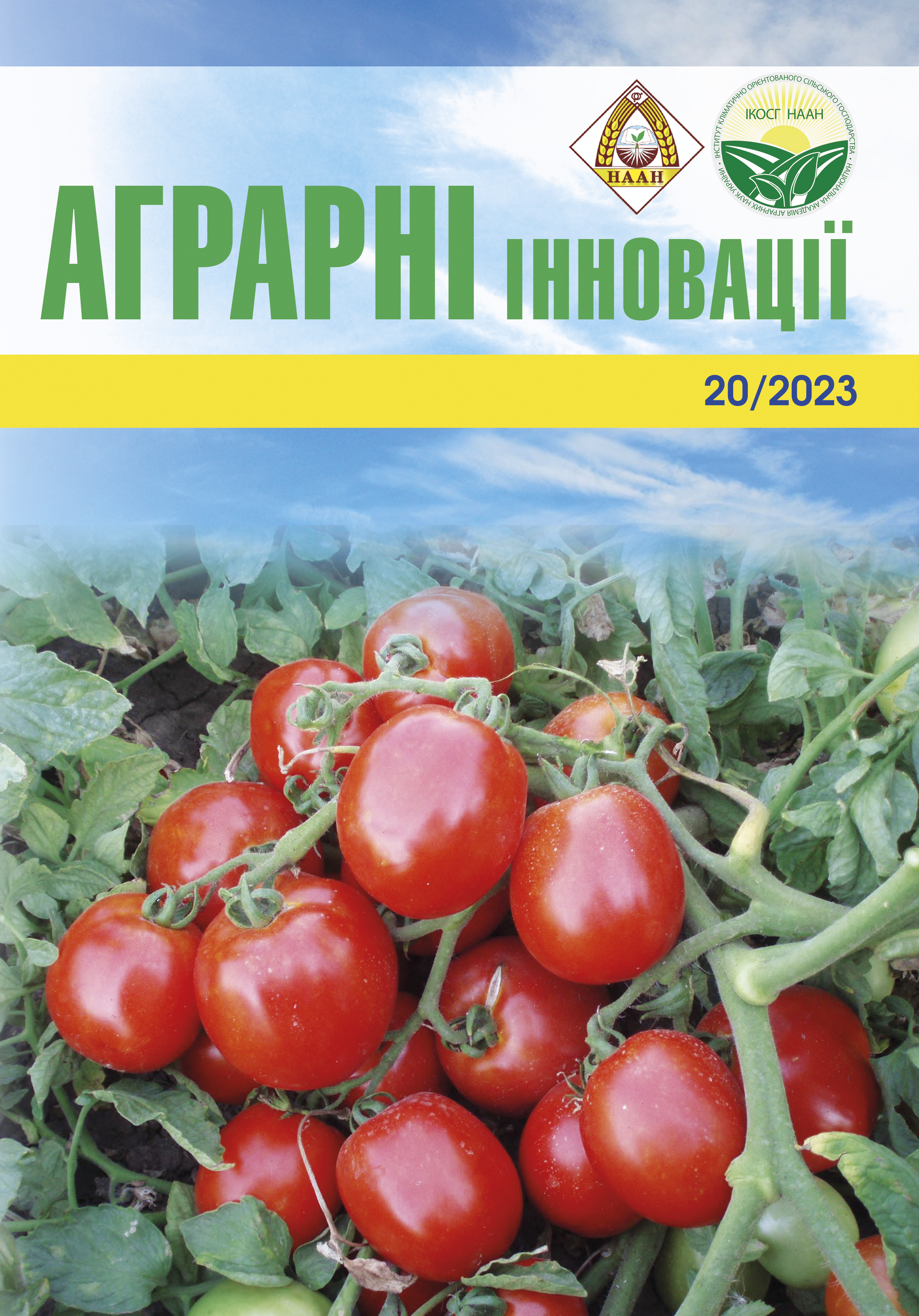The influence of the use of bacterial preparations and microfertilizers in growing peas
Abstract
Purposel. Study of the effect of processing pea seeds with biological preparations and microfertilizers on individual productivity and grain yield of pea varieties. Methods. Field, laboratory, mathematical and statistical. Results. Studies have shown that all the drugs used by us in the technology of growing peas are quite effective. Bacterization with the above preparations stimulated growth processes both at the beginning of seed germination and during the growing season of leguminous crops, which is confirmed by biometric measurements that the yield of pea varieties depended on the combined use of bacterial preparations, complex microfertilizers for foliar feeding and weather conditions in years of research. On average, for the years 2021–2023, the seed yield of pea varieties varied between 2.05–3.61 t/ha in the Hayduk variety and 2.28–3.94 t/ha in the Kareni variety. The average yield, depending on the studied elements of cultivation technology, was 2.90 t/ha in the Hayduk variety and 3.05 t/ha in the Kareni variety. In the years of the study, the yield rate increased by 0.15–0.24 t/ha in all varieties on average, due to the bactericidal of seeds with drugs. The use of mineral fertilizers at the rate of N30P60K60 enhanced the effect of bacterial preparations. Therefore, an increase in yield on these variants was observed by 0.77–0.86 t/ha, in accordance with the control. Conclusions. Based on the results of research, it was found that the use of mineral fertilizers contributes to better assimilation of bacterial preparations, as a result of increasing the productivity of peas. The best indicator of pea productivity was obtained in the variant with the application of pre-sowing treatment of the seed material with the biological preparation Optimai Puls against the background of mineral fertilizer N30P60K60 and carrying out foliar feeding of crops in the budding phase with the fertilizer Vuksal Microplant, which was 3.61 t/ha in the Hayduk variety and in the Kareni variety – 3.94 t/ha. The obtained data of experimental studies can be used in the development of a system of application of bacterial preparations and microfertilizers on pea varieties, on gray forest soils, which will allow to fully reveal the biological potential of the cultivated crop and stabilize a high level of productivity.
References
2. Коваленко О.А., Ключник М.А., Чебаненко К.В. Застосування біопрепаратів для обробки насіннєвого матеріалу пшениці озимої. Екологія. 2015. Вип. 244. Т. 256. C. 74–77.
3. Іщенко В.А., Бєлякова О.А. Ефективність мікродобрив, регулятора росту та ризогуміну у підвищенні продуктивності сортів гороху безлисточкового типу. Вісник Степу. 2009. № 6. С. 37–41.
4. Іщенко В.А. Ефективність використання ризогуміну і полі міксобактерину у поєднанні з мікродобривом та регулятором росту при вирощуванні гороху вусатого типу в північному Степу. Міжвідомчий тематичний науковий збірник Сільськогосподарська мікробіологія. Чернігів. 2013. Вип. 17. С. 89–100.
5. Конончук, О.Б. Ростові процеси та бобово-ризобіальний симбіоз сої культурної за передпосівної обробки насіння ріст-регуляторами Регоплант і Стімпо. Агробіологія. Зб. наук. праць БЦНАУ. 2012. Вип. 9 (96). С. 103–107.
6. Мурач О.М., Волкогон В.В. Формування симбіотичного апарату гороху за впливу бактеріальних препаратів, мікроелементів і стимулятора росту. Агроекологічний журнал. 2014. №4. С. 55–59.
7. Мусатов А.Г., Сидоренко Ю.Я., Бочевар О.В. Ефективність передпосівної обробки гороху гумат-мікроелементними препаратами в умовах північної підзони Степу. Бюлетень Інституту сільського господарства Степової зони НААНУ. 2010. № 38. С. 64–67.
8. Пилипенко В.С., Гончар Л.М., Каленська С.М. Формування продуктивності гороху залежно від елементів технології вирощування. Міжвідомчий тематичний науковий збірник «Землеробство». 2016. №91. Том 2. С. 51–55.
9. Плотніков В.В., Гильчук В.Г., Гуменний М.Б. Урожайність та якість зерна гороху при комплексному застосуванні системи агрохімікатів в сучасних конкурентоспроможних технологіях його вирощування.
10. Рудніченко Н. Природні ліки для грунту і джерело білка для людства. Пропозиція. 2019. №1. С. 24–29.
11. Тараріко Ю.О., Чорнокозинський А.В., Сайдак Р.В. [та ін.] Вплив агротехнічних і агрометеорологічних факторів на продуктивність агроекосистем. Вісник аграрної науки. 2008. №5. С. 64–67.
12. Чинчик О.С. Вплив обробки насіння біопрепаратами на показники структури урожаю та урожайність сортів гороху. Збірник наукових праць Подільського державного аграрно-технічного університету: Сільськогосподарські науки. 2016. Вип. 24. Частина 1. С. 222–228.






